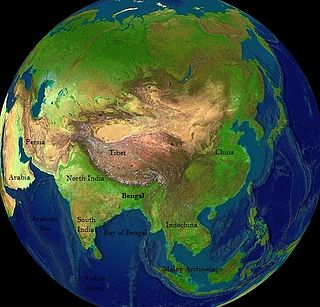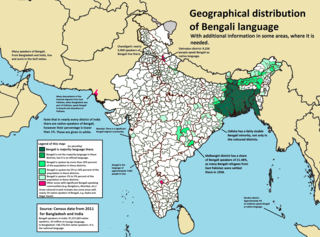
Bengal or endonym Bangla is a historical geographical, ethnolinguistic and cultural term referring to a region in the eastern part of the Indian subcontinent at the apex of the Bay of Bengal. The region of Bengal proper is divided between modern-day sovereign nation of Bangladesh and the Indian state of West Bengal.

Bangladesh is the eighth-most populated country in the world with almost 2.2% of the world's population. As per the final results of the 2022 Census of Bangladesh, the country's population is 169,828,911.

Dhaka Division is an administrative division within Bangladesh. Dhaka serves as the capital city of the Dhaka Division, the Dhaka District and Bangladesh. The division remains a population magnet, covers an area of 20,508.8 km2 with a population in excess of 44 million, It is the most populous country second level division of the world, growing at 1.94% rate since prior count, compared with national average of 1.22%. However, national figures may include data skewing expatriation of male labor force as gender ratio is skewed towards females.

Sylheti is an Indo-Aryan language spoken by an estimated 11 million people, primarily in the Sylhet Division of Bangladesh, Barak Valley of Assam, and northern parts of Tripura in India. Besides, there are substantial numbers of Sylheti speakers in the Indian states of Meghalaya, Manipur and Nagaland as well as diaspora communities in the United Kingdom, the United States, Canada and the Middle East.

Bangladesh is divided into 8 divisions (bibhag) and 64 districts, although these have only a limited role in public policy. For the purposes of local government, the country is divided into upazilas (sub-districts), "municipalities" or town councils (pourashova), city corporations and union councils . The diagram below outlines the five tiers of government in Bangladesh.

Chittagonian or Chittagonian Bengali is an Indo-Aryan language spoken in parts of the Chittagong Division in Bangladesh. Its speakers identify with Bengali culture and the Bengali language. Chittagonian and Standard Bengali are not inherently mutually intelligible, although it is considered as a nonstandard Bengali dialect. Chittagonian is considered to be a separate language by some linguists. It is mutually intelligible with Rohingya and to a lesser extent with Noakhailla. It is estimated (2006) that Chittagonian has 13 million speakers, principally in Bangladesh.

Eastern Bengal and Assam was a province of India between 1905 and 1912. Headquartered in the city of Dacca, it covered territories in what are now Bangladesh, Northeast India and Northern West Bengal.

The Bengali dialects or Bengali varieties are the varieties of the Bengali language that are part of the Eastern Indo-Aryan language group of the Indo-European language family widely spoken in the Bengal region of South Asia. The spoken dialects of Bengali are mutually intelligible with neighbouring dialects.
The phonology of Bengali, like that of its neighbouring Eastern Indo-Aryan languages, is characterised by a wide variety of diphthongs and inherent back vowels.
The indigenous people of Bangladesh are ethnic minorities in Chittagong Hill Tracts (southeastern), Sylhet Division (northeastern), Rajshahi Division (west), and Mymensingh Division (north-central) areas of the country. They are indigenous and the tribal races, total population of ethnic minorities in Bangladesh was estimated to be over 2 million in 2010. They are diverse ethnic communities including Tibeto-Burman, Austric and Dravidian people.

The following outline is provided as an overview of and topical guide to Bangladesh:

BBC Bangla is the Bengali language service of the BBC World Service, inaugurated in 1941 for Bengali audiences worldwide, especially the ones in the Bengal region, which includes the sovereign state of Bangladesh and the Indian states of West Bengal and Tripura.

Bengali, also known by its endonym Bangla, is an Indo-Aryan language from the Indo-European language family native to the Bengal region of South Asia. With approximately 240 million native speakers and another 41 million as second language speakers as of 2021, Bengali is the sixth most spoken native language and the seventh most spoken language by the total number of speakers in the world. It is the fifth most spoken Indo-European language.

Bangladeshis are the citizens of Bangladesh, a South Asian country centred on the transnational historical region of Bengal along the eponymous bay.

The divisions of Bangladesh are further divided into districts or zilas. The headquarters of a district is called the district seat. There are 64 districts in Bangladesh. The districts are further subdivided into 495 subdistricts or upazilas.

The Sylheti or Sylhetis are an Indo-Aryan ethnocultural group that are associated with the Sylhet region. There are strong diasporic communities in Barak Valley of Assam, India, North Tripura, as well as in rest of Bangladesh and northeast India. They speak Sylheti, an Eastern Indo-Aryan language that is considered "a distinct language by many and a dialect of Bengali by some others".

The Constituent Assembly of Bangladesh was the constituent assembly of Bangladesh. It was the country's provisional parliament between 1971 and 1973. In 1972, it drafted and adopted the Constitution of Bangladesh. The assembly was dominated by the Awami League, with a minority being independent lawmakers.
Dobhashi is a neologism used to refer to a historical register of the Bengali language which borrowed extensively, in all aspects, from Arabic and Persian. It became the most customary form for composing puthi poetry predominantly using the traditional Bengali alphabet. However, Dobhashi literature has also been produced in the Sylhet Nagri script, as well as in the modified Arabic scripts of Chittagong and Nadia. The standardisation of the modern Bengali language during the colonial period, eventually led to its decline.
Noakhailla (নোয়াখাইল্লা), Noakhali Bengali also known by the demonym Noakhalian, is a dialect of Bengali, spoken by an estimated 7 million people, primarily in the Greater Noakhali region of Bangladesh as well as southern parts of Tripura in India. Outside of these regions, there are substantial numbers of Noakhailla speakers in other parts of Bangladesh; as well as diaspora communities in the Middle East, Italy, Europe and the United States.

















